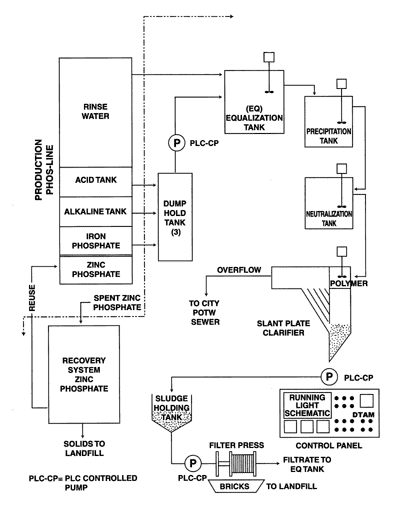Wastewater Challenges Simplified
Metal Forming and Coining consolidated three older plants into one state-of-the-art facility with one waste treatment system...
When Metal Forming and Coining, Inc. (MF&C) elected to consolidate multiple older plants into one state-of-the-art facility in Maumee, OH, 3 years ago, the firm had an opportunity to completely reassess its handling of plant wastewater. With the automotive industry as a primary market (cold-forged parts), the company positioned the new facility's processing layout to meet the trend toward increasing quality and environmental standards as demanded by the automotive manufacturers.
The new automated phosphating lines and associated wastewater treatment system also helped the company position itself to meet these increasing quality and environmental standards. MF&C was also able to meet increased production demands, since the new barrel process was able to phosphate the 1.25-4-inch diameter parts in 1 hour. It required about 8 hours in the older facilities.
"The demands on a treatment scheme for phosphating waste are nearly always complex, involving not only phosphate compounds as main streams but many side streams such as acids, caustics and soaps as well," noted Pete Paicer, engineer for Action Air and Hydraulics, Inc., which installed the Beckart system. Acid dumps, for example, typically contain a lot of scale, while a zinc phosphate operation may contain suspended solids, oil and grease as a result of cleaning and other surface preparation procedures; therefore, automation, equipment layout and appropriate chemistry become critical to system optimization and performance.
Working with SSOE, Inc., a Toledo, OH, architectural and engineering firm, MF&C opted for a PLC-controlled sedimentation wastewater treatment system manufactured by Beckart Environmental, Inc. The company had successfully completed a previous installation for MF&C and was able to participate from the earliest design stage of the new plant.
In planning the wastewater treatment system, the companies focused on lower operator time, decreased phosphate line chemical costs and minimizing waste. To save on operator time, the system was installed with an Allen-Bradley programmable logic controller and data table access module and supporting running light schematic.
Normal rinse waters are automatically sent to a large equalization tank. Rather than hauling the spent zinc phosphates to a landfill, they are first segregated into a waste dump tank. Then, the upper liquid (80-89%) portion is recovered for reuse while the lower settled solids are dewatered in a filter press. The acid, zinc phosphate and alkaline dumps are also transferred to separate holding tanks and pumped at brief, intermittent intervals by PLC-controlled air-operated pumps to the equalization tank.
The combined wastewaters can then proceed through the standard progression of treatment in the 800-gal precipitation tank, 800-gal pH-controlled neutralization tank, slant-plate clarifier, sludge thickener tank and filter press. Clear treated water from the top of the clarifier goes to the POTW sewer, while a PLC-controlled pump is used to pump settled floc from the bottom of the clarifier to the sludge thickener tank. A stroke-counting PLC-controlled pump then pumps the sludge to the filter press and turns on a cycle done light. Filtrate from the filter press is recirculated to the equalization tank, while the dewatered sludge is sent to a local landfill. The recovered zinc phosphate liquid is used back in the zinc phosphate tank.
The new automated phosphating and related waste treatment system has allowed MF&C to increase production and meet the quality demands of its automotive customers. "We can run production ‘flat out' with no problems," commented Jim Curtis, manager of MF&C. "The system is doing just what we need it to do, and we would do the same thing all over again if necessary."
MF&C's new wastewater treatment system helped lower operator time, chemical costs and the amount of sludge sent to landfill. Although the company has not been able to calculate the actual financial savings, it knows that it has saved money and time with the new system.
Continuous settling wastewater treatment flow diagram shows how the company is able to reuse nearly 90% of the liquid recovered from the production line.
Read Next
Education Bringing Cleaning to Machining
Debuting new speakers and cleaning technology content during this half-day workshop co-located with IMTS 2024.
Read MoreEpisode 45: An Interview with Chandler Mancuso, MacDermid Envio Solutions
Chandler Mancuso, technical director with MacDermid Envio discusses updating your wastewater treatment system and implementing materials recycling solutions to increase efficiencies, control costs and reduce environmental impact.
Read MoreDelivering Increased Benefits to Greenhouse Films
Baystar's Borstar technology is helping customers deliver better, more reliable production methods to greenhouse agriculture.
Read More











.jpg;maxWidth=300;quality=90)









